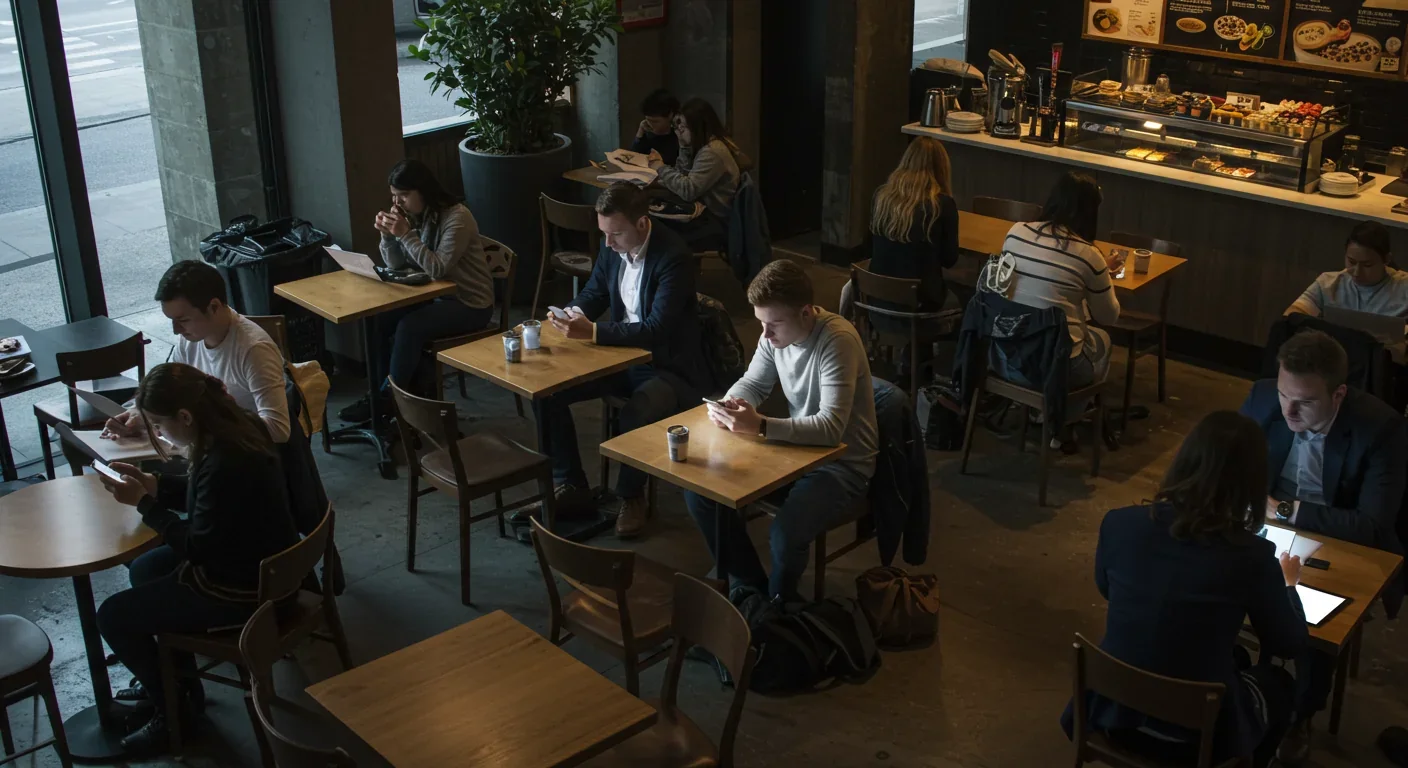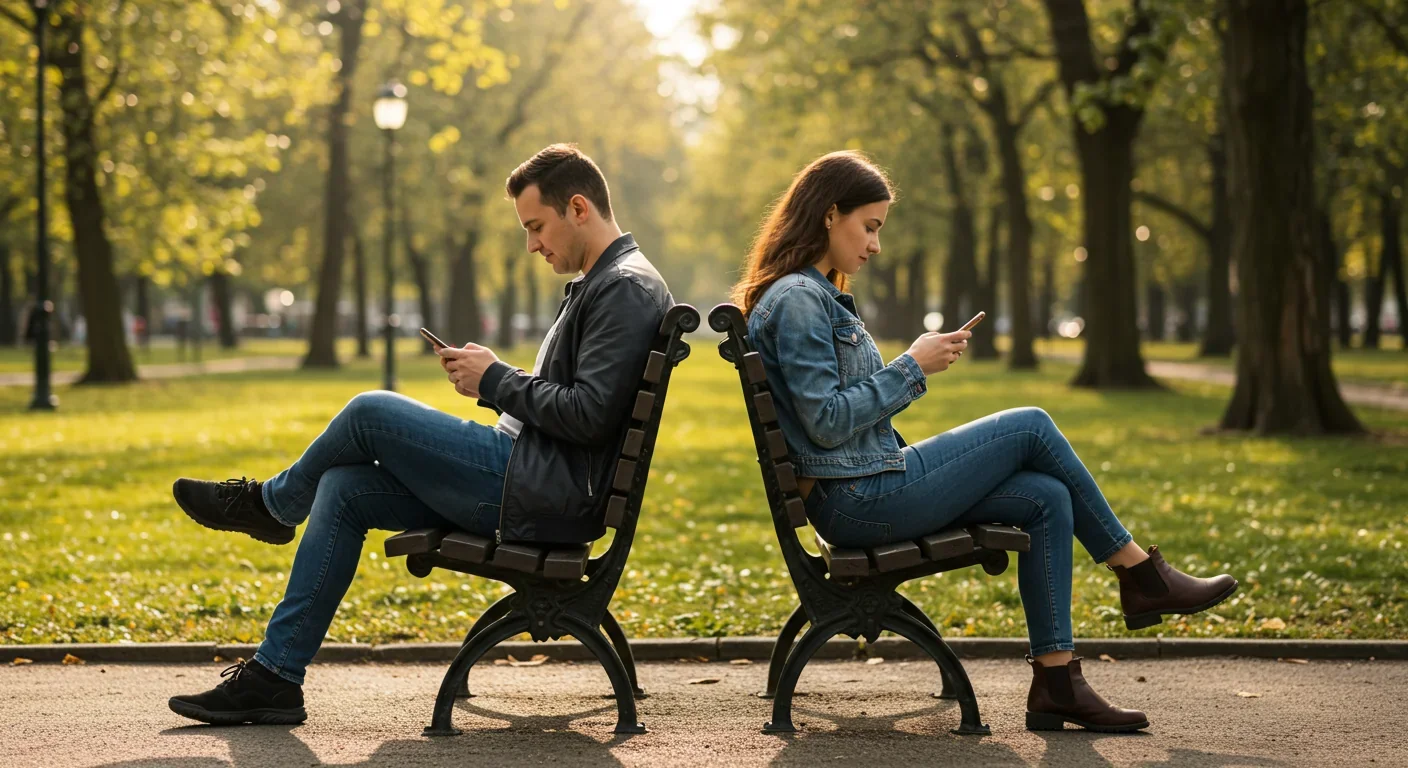Care Worker Crisis: Low Pay & Burnout Threaten Healthcare

TL;DR: Digital connectivity is fueling an epidemic of loneliness through social comparison, echo chambers, and reward hijacking. The solution isn't abandoning technology but using it intentionally to strengthen rather than replace real-world human connection.

By 2030, loneliness could surpass smoking as a leading cause of premature death. That's not hyperbole—it's what researchers are tracking right now. We've built the most connected civilization in human history, yet we're experiencing isolation at epidemic levels. The paradox isn't just ironic; it's reshaping how we work, love, and survive.
Here's the uncomfortable truth: more connectivity hasn't made us less lonely. It's made us more isolated.
Recent studies show that adults with higher social media use report increased depression, anxiety, and substance use. The mechanism? Cyberbullying, social comparison, and cognitive overload. Not exactly the connection revolution we were promised.
College students scrolling through Instagram experience something psychologists call upward social comparison—constantly measuring their lives against carefully curated highlight reels. The cognitive load from managing multiple digital identities while processing endless content streams creates what researchers identify as "digital exhaustion." Your brain wasn't designed to maintain 500 friendships simultaneously.
A cross-sectional study of 568 college students found that greater intensity of mobile social media use, upward social comparison, and cognitive overload all positively correlated with depressive mood. Translation: the more you use it, the worse you feel.
The dopamine loop doesn't help. Each notification triggers a tiny reward response, training your brain to crave digital validation. But here's the catch—that hit fades faster than real-world connection. You need more notifications, more likes, more engagement just to maintain the same feeling. Problematic social media use negatively correlates with resilience while positively correlating with loneliness, depression, and anxiety.
The shift didn't happen overnight. Think back to 2007—the iPhone launch. Before smartphones, if you wanted to connect with someone, you actually had to connect with them. Coffee shops were for conversation, not laptop farming. Waiting rooms meant awkward eye contact, not infinite scroll.
The printing press democratized knowledge but took centuries to reshape society. Television changed family dynamics over decades. Social media? It transformed human interaction in less than fifteen years.
Early internet optimists believed digital tools would enhance relationships, not replace them. Email would complement phone calls. Online forums would supplement real-world communities. Research from that era assumed technology would be additive, not substitutive.
But something unexpected happened: convenience became a trap. Why endure the friction of scheduling, commuting, and navigating complex social dynamics when you could get instant validation from a screen? Digital interaction became the path of least resistance.
The pandemic accelerated everything. Remote work, Zoom fatigue, delivery apps—suddenly avoiding in-person contact wasn't just convenient, it was necessary. We built infrastructure around isolation. Now we're stuck with it.
Historical analysis shows that major communication shifts always create adjustment periods. Telegraph operators in the 1840s worried about losing face-to-face business relationships. Radio threatened community gatherings. Each technology eventually found equilibrium.
The difference this time? Scale and speed. Previous communication revolutions affected specific sectors—business, entertainment, news. Smartphones infiltrated everything simultaneously: work, relationships, parenting, healthcare, politics. There's no safe space to maintain pre-digital patterns.

Three mechanisms explain why connectivity breeds isolation: social comparison, echo chambers, and reward hijacking.
Social comparison operates on a simple principle: we evaluate ourselves relative to others. Pre-digital era, your comparison group was limited—neighbors, coworkers, extended family. You knew these people. You understood context.
Social media exploded that reference group to thousands, many of whom you've never met. Worse, you're comparing your complete experience—boring commute, stressful work, mundane dinner—against their carefully curated highlights. The comparison isn't just unfair; it's psychologically destructive.
Research on Instagram's psychological impact reveals that young adults develop distorted self-perception from constant exposure to filtered, edited images. The phenomenon extends beyond body image to career success, relationship quality, and life satisfaction. Everyone else appears to be winning while you're just surviving.
Echo chambers promise community but deliver isolation. Algorithms optimize for engagement, which means showing you content you'll interact with—usually content that confirms existing beliefs. You feel surrounded by people who agree with you, which seems like connection.
It's not. Real connection requires encountering different perspectives, negotiating disagreement, and developing empathy for views you don't share. Echo chamber research demonstrates that ideological isolation increases over time, making real-world social interaction more difficult because you've lost practice navigating difference.
Reward hijacking explains the addictive quality. Your brain's reward system evolved to reinforce behaviors that aid survival—eating, socializing, reproduction. Social media companies employ psychologists and neuroscientists to exploit these circuits. The notification dopamine loop creates dependency without satisfaction.
Real relationships involve delayed gratification. You invest time, navigate conflict, provide support without immediate reciprocation. Digital interaction offers instant validation but no depth. Your reward system learns to prefer quick hits over substantial connection, the same mechanism underlying substance addiction.
A longitudinal study tracked individuals over time, finding that problematic social media use predicted increases in depression, anxiety, and loneliness. The directionality matters—it's not just that lonely people use more social media; social media use actively increases loneliness.
Mental health represents the most visible impact. Clinical research links chronic loneliness to depression, anxiety, and increased suicide risk. But the damage extends far beyond individual psychology.
Workplace productivity suffers measurably. Employee loneliness research shows that isolated workers experience decreased engagement, higher absenteeism, and faster burnout. The shift to remote work exacerbated existing problems. When work relationships exist entirely on Slack, who do you trust? Who mentors you? Who notices when you're struggling?
Post-pandemic workplace studies reveal that younger employees suffer most. They're building careers without the informal socialization that previous generations took for granted—hallway conversations, after-work drinks, mentorship lunches. Professional isolation compounds social isolation.
Civic engagement is collapsing. Community participation research demonstrates declining rates of volunteer work, local organization membership, and neighborhood interaction. Democracy requires citizens who know each other, who share physical space, who develop trust through repeated interaction.
When your community exists online, filtered by algorithms to match your preferences, there's no shared civic space. No town halls, no PTAs, no service clubs. Just thousands of isolated individuals, each in their own algorithmically optimized bubble.
Public health researchers increasingly view loneliness as a communicable condition. Lonely people withdraw from social networks, which increases loneliness in their former connections, creating a cascading effect. One lonely person in a social network increases loneliness risk for everyone within three degrees of separation.
The healthcare costs are staggering. Meta-analyses of loneliness impacts show increased risk for cardiovascular disease, stroke, dementia, and premature death. Chronic loneliness creates inflammation, weakens immune function, and disrupts sleep. It's not metaphorical damage—it's measurable physiological harm.

Let's be clear: digital tools aren't inherently destructive. The problem is how we're using them.
Research on healthy digital habits identifies key distinctions. Passive consumption—scrolling feeds, watching others' lives—correlates with loneliness. Active engagement—messaging specific people, scheduling real-world meetups, sharing vulnerable content—can strengthen relationships.
The difference matters because it points toward solutions that don't require abandoning technology entirely. That ship has sailed anyway. Nobody's giving up smartphones. The question is: how do we rewire our relationship with them?
Some companies are experimenting with connection-focused design. Instead of infinite scroll, time limits. Instead of likes and follower counts, private sharing. Instead of algorithms optimizing for engagement, tools that facilitate real-world meetups.
Community-building initiatives show promise when technology serves as infrastructure for in-person connection rather than replacement. Neighborhood apps that organize block parties. Hobby forums that become regular meetup groups. Professional networks that emphasize local chapters.
The key insight: digital tools should reduce friction for real-world interaction, not eliminate the need for it.
Loneliness isn't culturally uniform. Cross-cultural research reveals significant variation in how different societies experience and respond to isolation.
Japan's "hikikomori" phenomenon—young people withdrawing from society into complete isolation—predates smartphones but has intensified with digital connectivity. Government estimates suggest over one million Japanese live as hikikomori. The response has been community-based: volunteers visit homes, family support groups, gradual reintegration programs.
Scandinavian countries, despite high social media use, report lower loneliness rates. Why? Strong social safety nets, guaranteed vacation time, cultural norms around work-life balance, and robust community organizations. Technology hasn't replaced these structures; it supplements them.
In contrast, societies with weaker social infrastructure experience more severe loneliness impacts. United States, United Kingdom, and Australia—all English-speaking, individualistic cultures with limited social safety nets—show particularly high rates of isolation despite (or because of) high digital connectivity.
The pattern suggests that digital loneliness isn't purely technological. It's what happens when technology meets societies that have already weakened their social fabric. Where community bonds remain strong, digital tools cause less damage.
Individual action matters, but systemic change is essential.
For individuals: Implement digital hygiene. Treat social media like alcohol—fine in moderation, destructive in excess. Set boundaries: no phones during meals, designated screen-free hours, apps that enforce time limits.
Prioritize active over passive engagement. Message someone instead of scrolling. Schedule video calls instead of texting. Better yet, use digital tools to coordinate in-person meetings.
Join something—anything—that requires regular in-person participation. Book clubs, fitness classes, volunteer organizations, religious communities. The specific activity matters less than the routine commitment. Longitudinal studies show that regular social engagement, even when initially uncomfortable, significantly reduces loneliness over time.
For employers: Recognize that remote work has hidden costs. Create intentional opportunities for social connection. Regular team retreats, optional coworking days, funded social activities. The goal isn't forced fun—it's creating space for organic relationship development.
For communities: Invest in third places—spaces that aren't home or work where people naturally gather. Libraries, parks, community centers, public markets. Cities designed around cars and private spaces breed isolation. Cities designed around pedestrians and shared spaces facilitate connection.
For policymakers: Regulate attention-exploitation practices. Ban autoplay. Require transparent algorithms. Fund research on technology's social impacts. Loneliness is a public health crisis; treat it like one.
The loneliness epidemic threatens more than individual well-being. It's corroding the social bonds that make complex societies possible.
Democracy requires trust. Markets require cooperation. Innovation requires collaboration. All of these depend on human beings who know how to connect with each other—who can navigate disagreement, build coalitions, and maintain relationships across difference.
If we raise a generation that learned social interaction through screens, that treats in-person connection as optional, that derives self-worth from likes and follower counts, we're not just risking individual mental health. We're risking civilization's ability to solve collective problems.
Climate change, pandemic response, economic inequality—these challenges require unprecedented cooperation. They require societies where people care about strangers, where civic institutions command trust, where individuals feel invested in collective outcomes.
You can't build that through algorithms.
The next decade will determine whether we master digital tools or let them master us. The technology won't change—companies profit too much from exploiting attention. The question is whether we'll build social structures, cultural norms, and individual habits that preserve what makes us human: the messy, complicated, irreplaceable experience of genuine connection.
Because here's what the data makes clear: we weren't built for this. We evolved in groups of 150, with face-to-face interaction, with touch and eye contact and shared physical space. No amount of digital innovation changes that fundamental reality.
The solution isn't going backward. It's going forward with intention—using technology to enhance rather than replace the connections that sustain us. That's not nostalgia. It's survival.

Recent breakthroughs in fusion technology—including 351,000-gauss magnetic fields, AI-driven plasma diagnostics, and net energy gain at the National Ignition Facility—are transforming fusion propulsion from science fiction to engineering frontier. Scientists now have a realistic pathway to accelerate spacecraft to 10% of light speed, enabling a 43-year journey to Alpha Centauri. While challenges remain in miniaturization, neutron management, and sustained operation, the physics barriers have ...

Epigenetic clocks measure DNA methylation patterns to calculate biological age, which predicts disease risk up to 30 years before symptoms appear. Landmark studies show that accelerated epigenetic aging forecasts cardiovascular disease, diabetes, and neurodegeneration with remarkable accuracy. Lifestyle interventions—Mediterranean diet, structured exercise, quality sleep, stress management—can measurably reverse biological aging, reducing epigenetic age by 1-2 years within months. Commercial ...

Data centers consumed 415 terawatt-hours of electricity in 2024 and will nearly double that by 2030, driven by AI's insatiable energy appetite. Despite tech giants' renewable pledges, actual emissions are up to 662% higher than reported due to accounting loopholes. A digital pollution tax—similar to Europe's carbon border tariff—could finally force the industry to invest in efficiency technologies like liquid cooling, waste heat recovery, and time-matched renewable power, transforming volunta...

Humans are hardwired to see invisible agents—gods, ghosts, conspiracies—thanks to the Hyperactive Agency Detection Device (HADD), an evolutionary survival mechanism that favored false alarms over fatal misses. This cognitive bias, rooted in brain regions like the temporoparietal junction and medial prefrontal cortex, generates religious beliefs, animistic worldviews, and conspiracy theories across all cultures. Understanding HADD doesn't eliminate belief, but it helps us recognize when our pa...

The bombardier beetle has perfected a chemical defense system that human engineers are still trying to replicate: a two-chamber micro-combustion engine that mixes hydroquinone and hydrogen peroxide to create explosive 100°C sprays at up to 500 pulses per second, aimed with 270-degree precision. This tiny insect's biochemical marvel is inspiring revolutionary technologies in aerospace propulsion, pharmaceutical delivery, and fire suppression. By 2030, beetle-inspired systems could position sat...

The U.S. faces a catastrophic care worker shortage driven by poverty-level wages, overwhelming burnout, and systemic undervaluation. With 99% of nursing homes hiring and 9.7 million openings projected by 2034, the crisis threatens patient safety, family stability, and economic productivity. Evidence-based solutions—wage reforms, streamlined training, technology integration, and policy enforcement—exist and work, but require sustained political will and cultural recognition that caregiving is ...

Every major AI model was trained on copyrighted text scraped without permission, triggering billion-dollar lawsuits and forcing a reckoning between innovation and creator rights. The future depends on finding balance between transformative AI development and fair compensation for the people whose work fuels it.